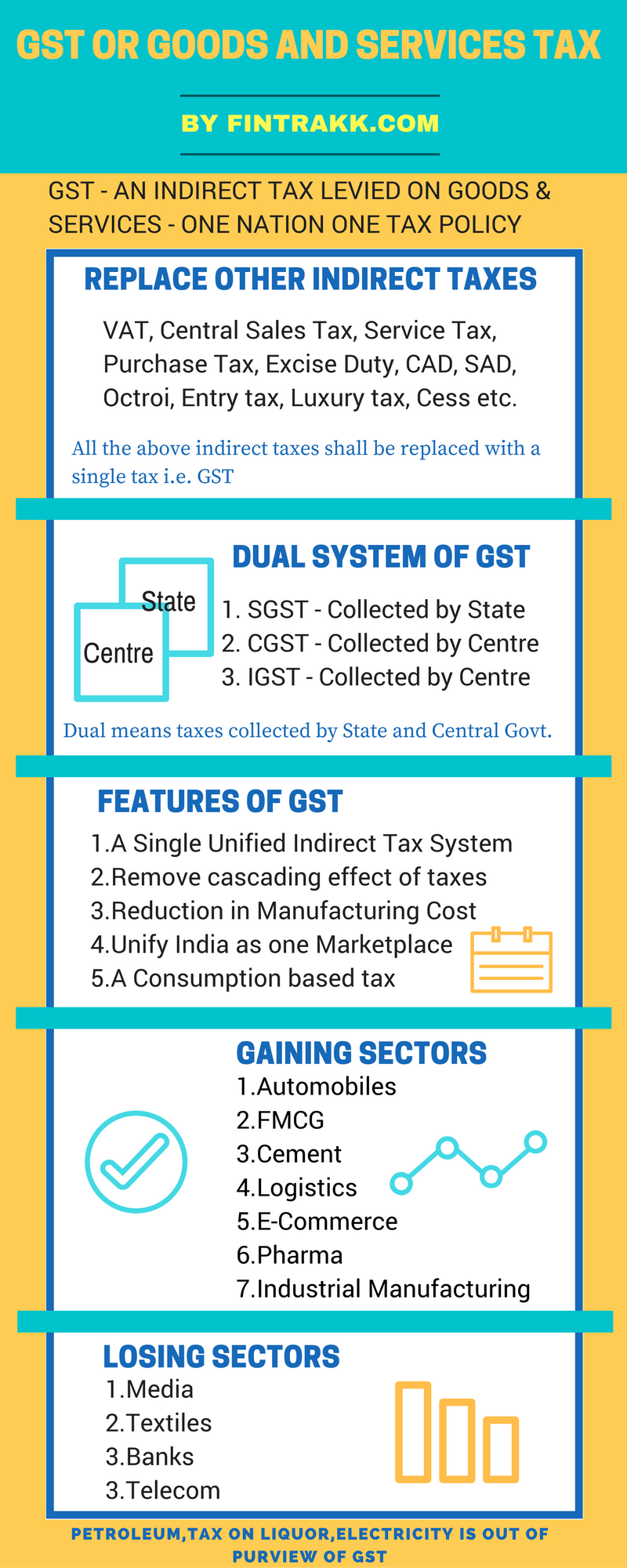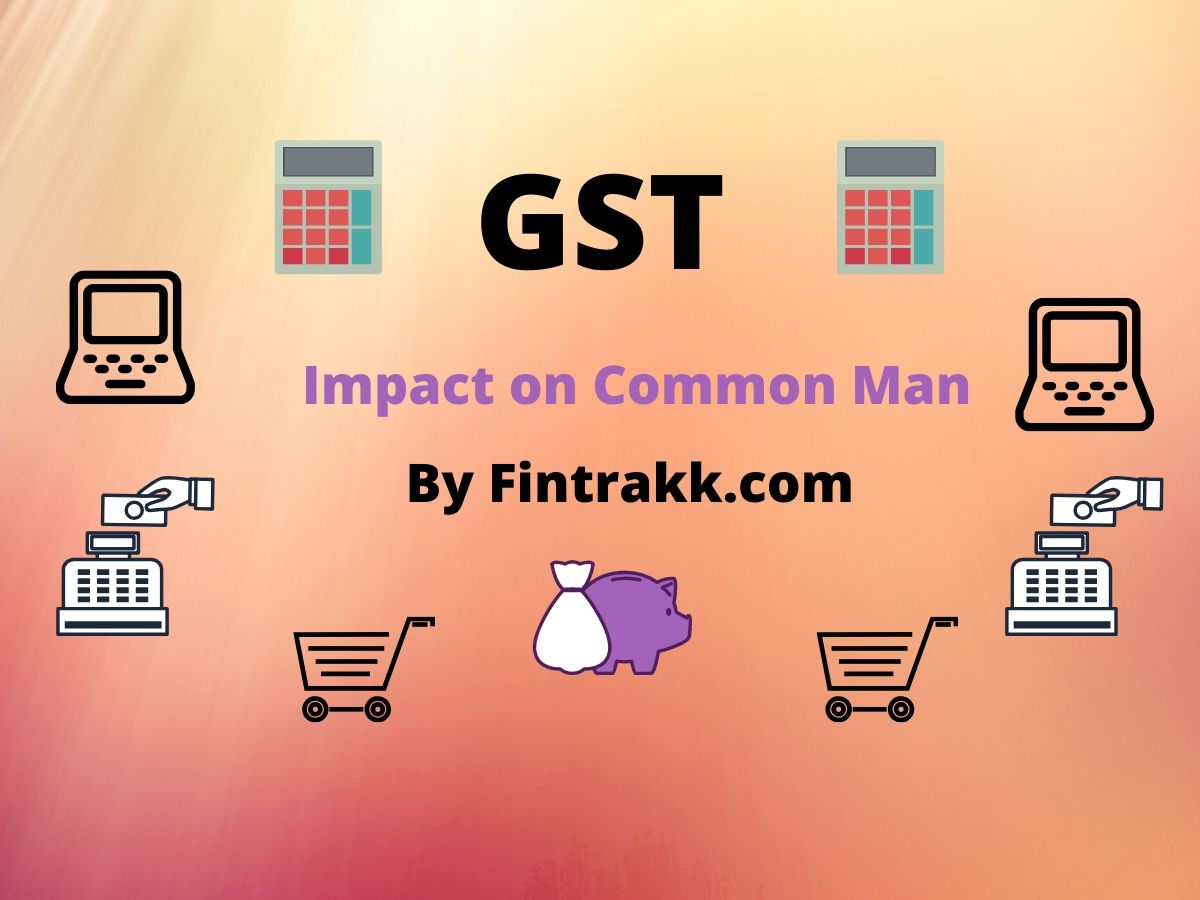Through this blog you shall become familiar about GST or Goods and Services Tax: Impact of GST on common man. What are the advantages and disadvantages of GST in India. How it will impact our the life of a common man? How the common man will benefit from GST ?
GST or Goods and Services Tax was introduced in July 2017 in India. GST had been a hot topic of discussion everywhere in the year of its introduction. No wonder, it still remains a trending topic to discuss around. Being be aware of different aspects of GST has become all the more essential.
Keep reading further, to have a deeper insight of the positive as well as the negative Impact of GST on common man.
GST or Goods & Services Tax: Facts
Presently, there are around 160 countries that have implemented GST/VAT in some form or the other. In few countries, VAT is the substitute for GST. But, conceptually it is a destination based tax that is being levied on the consumption of goods and services.
- An interesting fact, France was the first to introduce GST or Goods and Services tax.
- Presently, only Canada has a dual GST model.
- The rate of GST normally ranges in between 15–20% only. However, it may differ to a higher/lower side in some of the countries.
The rates of GST play a crucial role in its successful implementation. Various countries have been struggling to rationalize the rate structure.
India finally launched the new GST or Goods and services tax after crossing the various hurdles that came its way.
Have a look at the Infographic below, that will give you an overview of GST or Goods and Services tax:

What is GST or Goods & Services tax? What is its Impact on the Common Man ?
GST or Goods and Services Tax as the name implies, it is an indirect tax applied both on goods and services at a uniform rate. This means goods and services will be subject to a uniform tax rate and both will be treated at par.
A single form of tax known as GST or Goods and services tax will be applied throughout the country, replacing a number of other indirect taxes like VAT, Service tax, CST, CAD etc.
GST or Goods and Services Tax – Being a new law, a new tax that brought with it new challenges to face. Hence, this had to be tackled with utmost care.
So, GST bill covered the Goods and Services Tax i.e. the biggest indirect tax reform providing a uniform and simplified way of Indirect taxation in India. GST replaced a number of other indirect taxes like VAT, CST, Service tax, CAD, SAD, Excise, Entry tax, purchase tax etc.
So, a bundle of indirect taxes got replaced by a new tax in India known as GST or Goods and Services Tax. Hence, leading to a much simplified tax regime as compared to the earlier complicated tax structure comprising of numerous taxes.
As and when a new reform or bill comes and a new law is imposed, it surely leaves its impact especially on the common man. It is ultimately the common man who is directly or indirectly affected by the implementation of any new tax.
And this time too there’s was no exception, the common man had to get ready for the implications. Who is the common man here? This includes not only the final consumer of goods but all the small traders and service providers who are directly affected after the introduction of GST.
Here, we have tried to cover up the major points related to Impact of GST on the common man or the final consumer. You shall also know the overall impact of GST.
Simply stated, we have highlighted the main advantages and disadvantages of GST. How GST impacts the common man?
GST Slab rates: On Introduction
- Zero rated items: Foodgrains used by common people. ( A sigh of relief…hmmm…)
- 5% Rate: Items of mass consumption including essential commodities will have low tax incidence.
- 12% and 18 % Rate: Two standard rates had been finalised as 12% and 18%. Most commonly, you’ll hear an 18% rate on different goods and services.
- 28% Rate : White goods like Air conditioners, washing machines, refrigerators, soaps and shampoos etc. that were taxed at 30-31% shall be now taxed at 28%.
Demerit goods like tobacco, tobacco products, pan masala, aerated drinks and luxury cars shall be charged at the highest rate of 28%. An additional cess on some luxury goods shall also be imposed.
Services that were earlier taxed at 15% shall be taxed at a higher rate of GST @ 18%. Various goods have been classified to fit into the above categories.
Important Note: The GST rates given above are a general overview of rates when this new tax system was initially launched. GST rates have been revised on various occasions and might vary on different category of items. Kindly check the respective rates from a tax consultant.
Positive Impact of GST on Common Man: Advantages of GST
- GST was launched as a unified tax system removing a bundle of indirect taxes like VAT, CST, Service tax, CAD, SAD, Excise etc.
- A simplified tax policy as compared to earlier tax structure. However, it was not as simple as it seemed to be, Check disadvantages below to grab more details.
- GST or Goods & Services tax removes cascading effect of taxes i.e. removes tax on tax.
- Due to lower burden of taxes on the manufacturing sector, the manufacturing costs will be reduced. Hence, prices of consumer goods likely to come down.
- Due to reduced costs some products like cars, FMCG etc. will become cheaper.
- This will help in lowering the burden on the common man. You will have to shed less money to buy the same products which were earlier costly.
- The low prices will further lead to an increase in the demand/consumption of goods.
- Increased demand will lead to increase supply. Hence, this will ultimately lead to rise in the production of goods.
- The increased production will lead to more job opportunities in the long run. But, this can happen only if consumers actually get cheaper goods.
- It will curb circulation of black money. This can happen only if the “kacha bill” system, normally followed by traders and shopkeepers is put to check.
- A unified tax regime will lead to less corruption which will indirectly affect the common man.
- Most importantly, experts hope to see a positive impact of GST on Indian economy in the long run.
But, this is possible only if the actual benefit of GST is passed on to the final consumers. There are various other factors also like the sellers profit margin that determine the final price of goods. GST alone does not determine the final price of goods. The anti-profiteering clause has been inserted in the GST Act to protect the interest of the consumers.
Negative Impact of GST on Common man: Disadvantages of GST
- Compliance burden: You need to deposit GST and file returns on time. GST returns filing is not as easy as it seems to be. You need to hire a tax professional to manage it. Although, Government has been taking steps to simplify the returns filing and keep it simple. But, still it will take time to actually smoothen the entire process.
Although big businesses having ample staff can handle the whole process very easily. But, what about small traders/service providers or individuals who have just started their business or service, isn’t that getting a bit complex for them? A small exemption in this regard might be a big sigh of relief for such people!
- Service tax rate @ 15% is presently charged on the services. So, if GST is introduced at a higher rate which is likely to be seen in the near future, the cost of services will rise. GST shall be charged @18% on maximum services and shall reach upto 28% for few services. In simple words, all the services like telecom, banking, airline etc. will become more expensive.
- Increased cost of services means, an add on to your monthly expenses.
- You will have to reschedule your budgets to bear the additional services cost.
- Businessmen and service providers are still learning about the new laws. This will increase reliance on tax experts and professionals and further add to your business expenses.
- Being a new tax, it will take some time for the people to understand it completely. Its actual implications can be seen after a certain period of time.
- It is easier said than done. There are always some complications attached. It is a consumption based tax, so in case of services the place where service is provided needs to be determined.
- Proper invoicing and accounting needs to be done to ensure better compliance. However, GST Accounting Software are being developed in this regard by various companies.
- If actual benefit is not passed to the consumer and the seller increases his profit margin, the prices of goods can also see a rising trend.
- An increase in inflation might be seen initially that may come down gradually.
- A strict check on profiteering activities will have to be done, so that the final consumer can enjoy the real benefits of GST.
- Although, a large number of officers have been trained and a systematic IT software developed for the successful implementation of GST. But, it will take some time for the people including the manufacturers, the wholesalers, the retailers or the final consumers to understand the whole process and apply it correctly.
GST Impact on Common Man
In the year of its launch, a range of GST training and Courses had been provided by the Government, various institutions and companies to educate the people all around.
However, GST or Goods and Services tax is a long term strategy planned by the Government. So, its positive impact shall be seen in the long run only.
A well designed GST Policy can bring a qualitative and real change in the tax system of India.
A massive IT Software has been developed for the successful implementation of GST to bring things online. Revenue officials were also being trained for turning GST into a reality. But, the actual performance and results can be visualised over the years.
Talking about the different sectors, some might have gained, some might have lost. But, ultimately we will have to get used to this new tax. A landmark reform having a great impact on India and its taxation system.
Also read : 10 Best Credit Cards in India: Review!
Let us hope GST or Goods and services tax leaves a positive impact and helps to boost up the Indian economy and convert India into a unified national market with simplified tax regime.
A rising Indian economy will anyways help in the financial growth of the common man!
Conclusion
Let us hope this “One nation, one tax” proves to be a game changer in a positive way and proves to be beneficial not only to the common man but to the country as a whole.
What are your views regarding GST and its impact on the common man? Do you feel it will help the common man? Will it lower the tax burden?
How positively it will impact the life of a common man? Feel free to give your opinion on the same to help our readers learn more about GST! And yes, don’t forget to share it with your family and friends, after all GST an interesting topic that everyone wants to know about.
Also,have a look at one of our most popular blog post on Investments to help you in your right investment planning: 7 Best Long term Investments in India !

